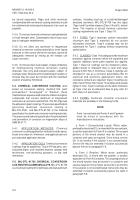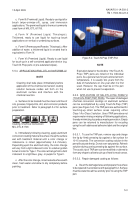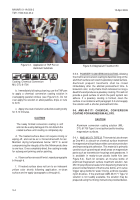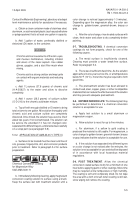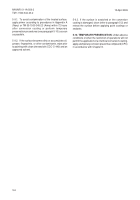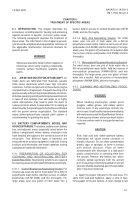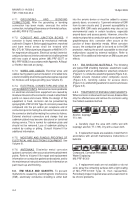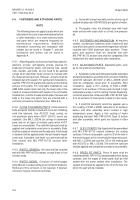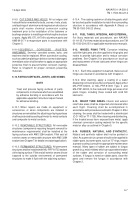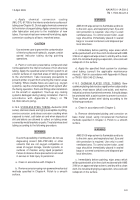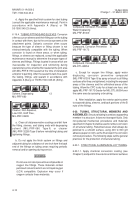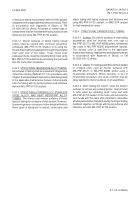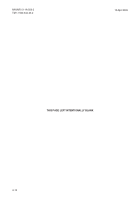TM-1-1500-344-23-2 - Page 108 of 240
6-4
NAVAIR 01-1A-509-2
TM 1-1500-344-23-2
15 April 2009
6-7.1.
GROUNDING
AND
BONDING
CONNECTIONS. After the grounding or bonding
connection has been made, overcoat the entire
connection, including all bare areas on the metal surface,
with MIL-PRF-81733 sealant.
6-7.2.
CONDUIT AND JUNCTION BOXES. If
corrosion is found, remove by mechanical methods
outlined in Chapter 4. Before applying primer, reworked
and bare metal areas shall be treated with
MIL-DTL-81706 for aluminum alloy parts or AMS-M-3171
for magnesium alloy parts. Electrical conduit (exterior)
and junction boxes (interior and exterior) shall be primed
with two coats of epoxy primer (MIL-PRF-23377 or
MIL-PRF-85582) in accordance with Appendix A (Navy)
or TM 55-1500-345-23 (Army).
6-7.3.
WIRES AND CABLES. Electrical wires and
cables having plastic jacket insulation or braided wire
exterior shielding shall not be painted except as required
for moisture and fungus proofing (see Volume III).
6-7.4.
ELECTRICAL CONNECTORS AND LEAD-IN
ATTACHMENT POINTS. Almost all corrosion problems
on electrical and electronic equipment are caused by
moisture intrusion at the connector or lead-in attachment
points on cases and covers. While the design of this
equipment is fixed, corrosion can be prevented by
spraying MIL-PRF-81309 Type III corrosion preventive
compound into the pin and/or pin receptacle end of
connectors prior to mating the connector halves and on
the connector shells after mating the connector halves.
External electrical connectors and clamps that are
cadmium plated may become discolored or tarnished
during service. This is normal for cadmium plate and
should not be removed. Loss of cadmium plating is
evident by rusting or pitting. Consult Volume III for
additional information.
6-7.5.
MOISTURE AND FUNGUS PROOFING OF
ELECTRICAL AND ELECTRONIC EQUIPMENT. See
Volume III.
6-7.6.
ANTENNAS. Dissimilar metal corrosion
(galvanic corrosion) often occurs at antenna attachment
points. Refer to Volume III for repair and replacement
information on conductive gaskets and sealants, and to
the maintenance instruction manuals for information on
paint touch-up and finishing.
6-8.
EMI SEALS AND GASKETS.
To prevent
malfunctions caused by electromagnetic interference
(EMI), electrically conductive shielding is either built
into the avionic device or must be added to access
panels, doors, or covers to: 1) prevent emission of EMI
from its own circuits and; 2) prevent susceptibility to
outside EMI. EMI seals and gaskets may also act as
environmental seals in certain locations, especially
around doors and access panels. However, since the
seals must provide a conductive path to an aluminum or
graphite/epoxy skin, corrosion often occurs at the
junction of these dissimilar metals. When corrosion
occurs, the conductive path is lost and so is the EMI
protection, making the aircraft susceptible to electrical
malfunctions caused by external radiation. Refer to
Volume III for additional information on EMI causes and
effects.
6-8.1.
EMI SHIELDING MATERIALS. The following
are typical EMI shielding materials: elastomeric seals
and gaskets with an embedded or attached conductor
(Figure 6-1), conductive elastomer gaskets (Figure 6-2),
metallic screens installed under composite covers
(Figure 6-3), bonding cables for access doors
(Figure 6-4), and bonding washers for avionics enclosure
(Figure 6-5).
6-8.2.
TREATMENT OF EMI SEALS AND GASKETS.
When corrosion is observed in such areas, disassemble
only the affected area and remove the corrosion using
the mildest available method.
Alcohol, Isopropyl
1
TT-I-735
a. Carefully clean the area with cloths wet with
isopropyl alcohol (TT-I-735). Dry with a clean cloth.
b. If replacement seals are available, install them in
accordance with aircraft maintenance instructions or
bulletins.
Compound, Corrosion Preventive
4
Water Displacing
MIL-PRF-81309
c. If replacement seals are not available or do not
exist, spray the contacting surfaces with a light coating
of MIL-PRF-81309 Type III, then reassemble.
Periodically inspect repaired areas and areas known to
be chronic problems.
Back to Top



